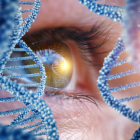In 1930, a key milestone occurred in the history of our species, much less known than the discovery of penicillin by the doctor Alexander Fleming (in 1928). For the first time, an antibiotic was used successfully. penicillin, to cure four patients affected by bacterial eye infections. That event also marked the beginning of a permanent arms race between pathogenic bacteria and humanity. The “confrontation” between natural selection and evolution acting on these microorganisms, on the one hand, and the ingenuity and effort of scientists, on the other.
Antibiotic resistance enzymeShutterstock
From the moment people began to have specific weapons aimed at attacking bacteria, they began to slowly but inexorably acquire “shields” to resist its effects. Thus, the large-scale production of penicillin and other antibiotics since the 1940s saved many people from bacterial infections, but it also implied stepping on the accelerator of an inevitable phenomenon: the generation of resistance.
A predictable destiny
Fleming was aware, from very early on, that penicillin could no longer be effective. Upon receiving the Nobel, was frank in his speech: «Perhaps the time will come when anyone can buy penicillin in stores. There is a danger that the ignorant man will easily take an insufficient dose and by exposing his microbes to non-lethal amounts of the drug, these become resistant».
The doctor’s prediction would not take long to come true: less than 10 years after the use of penicillin spread throughout the world, the first bacterial resistance began to be detected.
According to recent estimates, Antibiotic-resistant bacteria could become the leading cause of death in the world by 2050, ahead of cancer and cardiovascular diseases. If drastic measures are not taken to avoid it, these microorganisms will cause 10 million deaths each year. A joint report by the World Health Organization (WHO), the United Nations (UN) and other institutions warns about this without half measures: «There is no time to lose. Unless the world acts urgently, antimicrobial resistance will have a disastrous impact on a generation.
For now, the death toll caused by resistant bacteria has not stopped increasing globally. The latest detailed scientific study on the impact of these microorganisms in the world, published in 2022, estimates that In 2019 alone, there were almost 1.3 million deaths caused directly by resistant bacteria and nearly 5 million deaths associated with them. In Spain, around 6,200 people died directly from this cause and approximately 27,300 deaths were associated with infections with bacterial resistance.
The most vulnerable people are children under 5 years: one in five deaths occurred in this group. On the other hand, the regions most affected by the impact of the resistance were the poorest, with a shortage of resources to confront it: Sub-Saharan Africa and South Asia.
Only six species of resistant pathogenic bacteria are responsible for almost all direct deaths (929,000 deaths in 2019), with Escherichia coli and Staphylococcus aureus bacteria leading the way.
Will we gain enough time to incorporate new weapons against superbugs? Only time will tell. The future of a multitude of human lives depends on it.Pixabay
The threat of superbugs
The emergence of more and more resistance over time has led to the generation of superbugs: specific strains of certain species of bacteria that are resistant to multiple types of antibiotics. The treatment of infections caused by these microorganisms can be extremely complicated because conventional antibiotics do not work against them and it is necessary to wait for the microbiological tests to identify which antibiotics are sensitive to. For this reason, people affected by superbugs have a much higher risk of complications and death.
For certain patients, it may be necessary to prescribe higher doses of antibiotics or change to other types of antibiotics, more effective, but with more Adverse effects, which implies more risky treatments. This is where the so-called last resort antibiotics: drugs used in people with life-threatening infections caused by multidrug-resistant bacteria. These antibiotics still retain a high effectiveness against them and They are used when all else fails. In this group of valuable medications we find, among others, carbapenems, some cephalosporins and colistin. The latter, colistin, is used in medicine when there is no other option in serious infections because its side effects are considerable.
Unfortunately, heBacteria are also gradually generating resistance to the precious antibiotics of last resort., our last barrier against them. In fact, there is no antibiotic, today, that has not lost effectiveness to a greater or lesser extent against bacteria.
Sometimes finding an antibiotic that is effective against a certain superbug it may be impossible. More and more cases are being detected around the world of people with infections caused by bacteria. resistant to all or almost all known antibiotics or to all the antibiotics available in the country. Especially famous was the case of a woman from Nevada (United States) who died of an incurable infection due to the bacteria. Klebsiella pneumoniae in 2016. Doctors performed antibiotic sensitivity tests to check which of them he was sensitive to in order to prescribe treatment. It was useless: the bacteria was resistant to all available antibiotics (26 different types) in the North American nation. Professor James Johnson, a specialist in infectious diseases at the University of Minnesota, explained the event to the media: “I think this is the harbinger of a bad future that is yet to come.”
We must buy time to create new weapons against superbugsE.Samper
This is how superbacteria are generated
In the same way that no one can stop the evolution of speciesthe emergence of bacterial resistance It is an inevitable natural process, can’t stop. However, humans have accelerated this process to an extreme degree due to the indiscriminate use of antibiotics in both the medical and veterinary fields. Every time someone takes one of these drugs to treat a cold or flu (caused by viruses), or every time a farmer abuses antibiotics by administering them to your animals you are taking foolish steps towards a potential post-antibiotic era.
The generation of resistance It is a process of pure chance, natural selection and evolution. There is no “will” for bacteria to become resistant to antibiotics in order to survive and leave vast offspring that spread around the world and kill millions of humans. Like the rest of the species that populate the planet, bacteria suffer random mutations in their DNA or RNA. Yes, by chance of life, These mutations represent an advantage over the others to adapt to the environment and multiply, they spread and predominate. In a world in which humans frequently use antibiotics, especially in hospitals and farms, bacteria that have acquired mutations that generate resistance to antibiotics are the “queens” of the place. While other bacteria succumb to the effects of antibiotics, they survive and expand. The more resistance they accumulate to various antibiotics, the more likely they are to resist and multiply. Evolution in its purest form.

The ability of bacteria to adapt to inhospitable conditions is truly surprising. These organisms can be found in many extreme regions of the Earth, whether in burning fumaroles of ocean trenches or in extremely saline areas such as the Dead Sea. It is not surprising, therefore, that in less than a century since the discovery of antibiotics by humanity, we already have serious problems defending ourselves against multi-resistant bacteria.
Two characteristics are key to the success of bacteria in generating resistance:
- They undergo mutations quite frequentlycompared to animal species.
- Are able to exchange genes between them (not just to their descendants), a process called horizontal gene transfer.

The globalization that the human species is experiencing also favors the transport of bacteria between different corners of the Earth. In this way, when a resistant bacterial strain is identified in a specific country, it does not usually take many years until it is detected in other countries.
The speed with which these microorganisms can generate resistance and spread throughout the world is as amazing as it is terrifying. Bacteria of the genus Campylobacter, responsible for a large part of the foodborne bacterial infections that appear in the world, are good proof of this. In just ten years, these microorganisms went from having virtually no resistance to one in six cases of infections due to them were due to strains resistant to fluoroquinolones (the antibiotics of choice against them).






